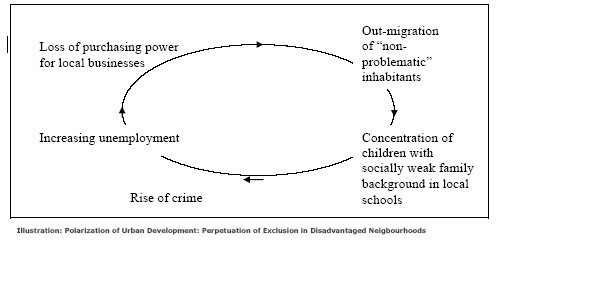1 The practice
1.1 Description of the project
In an attempt to prevent the creation of “hot spots”, the city of Berlin has launched the “area management programme” in 17 neighbourhoods with a total of 227,000 inhabitants. One of these neigbourhoods is the area “Soldiner Kiez”. Different from former programmes of urban renwal, “area management” does not primarily seek to improve housing structures and public infrastructure. Instead the programme’s philosophy is based on the assumption that it is important to strengthen and interlink the activities of active inhabitants, local institutions and businesses. The envisioned mobilisation of endogenous potentials is seen as a strategy to prevent the detoriation of living conditions in these areas.
At the centre of the “area management” strategy is the creation of an agency (the “Area Management”), which organizes events in the area and initiates communication between various local stakeholders. The city chose to assign private non-commercial companies to this task. Even though the agency is not directly part of the city administration, it is nevertheless seen as an attempt
- to reduce the distance between city administration and the citizen (by being directly on the spot)
- to overcome the typical administrative division of tasks along sectorial lines.
To achieve the second-mentioned objective, the city created an “Area Management Commission” that unites representatives of all crucial departments of the city administration (e.g. education, labour, city development).
The design and methodology of the programme reflects also the fact that the city of Berlin cannot afford to spend as many resources for urban renewal as it did during the 1970s and 1980s. Therefore the biggest challenge in the project realization is how to convince local inhabitants (especially those of migrant background) that it makes sense to become more active. The interesting and successful mobilization method presented in this case study has been the creation of “area funds”, which are administrated by councils that were elected by the local inhabitants.
1.2 Time, structure and steps of the project
The “Area Management Soldiner Strasse” started to work in 1999. It is responsible for a clearly designated area in the outer inner city of West Berlin, which is home to about 15,000 inhabitants. To better convince citizen that it makes a difference if they become active for their neigbourhood, Berlin´s department for city development decided in 2001 to launch as a pilot project the “Area Fund”. Together with the 16 other “areas with particular development needs”, the area received a special donation of € 500,000, which could be used for programmes that would improve the quality of life in the disadvantaged neigbourhoods. The citizens were called to vote representatives from their ranks, who would decide how to use this money. The programme was from the beginning envisioned as a temporary intervention, which would start off the process of citizen participation. It took place in 2001 and 2002. The elected “area council” decided to support a total of 27 projects of initiatives that are based in the neigbourhood. After the end of the “area fund” programme, the elected representatives still decide upon the usage of resources of the “Area Action Fund”. The available sums are, however, much more limited.
1.3 Place and context
Since the reunification of Berlin, the city’s development is increasingly characterised by the polarization between “good” and “problematic” neighbourhoods. Characterised by high unemployment rates, a high percentage of foreign-born population, and problems with crime, the latter suffer under stigmatisation and the flight of more affluent citizens. Due to this out-migration, urban sociologists fear that the development of certain neighbourhoods might lead into a viscous circle.

The above-described problems seem especially urgent in the area around “Soldiner Strasse”, which is known for its high crime rate. A very high percentage of the 15000 people living in the area is unemployed and more than 40 per cent are holder of foreign pasports.
1.4 Target
The “Area Management” seeks to reach all inhabitants of the area around Soldiner Strasse. It is, however, a recurring experience that it is especially difficult to reach out to people of foreign background, who might lack access to information on participatory events or encounter language difficulties. The “area management” sought therefore to especially address these groups of citizens.
1.5 Methodology
Area Management is a complex programme. Hence, we will at this point mention only project elements, which are important in regard to the “Neigbourhood Fund”:
- Creation of an intra-departmental commission for the “Area Management Programme”
- Designation of 15 “areas with special development needs” (Gebiete mit besonderem Entwicklungsbedarf) in 1999. Later, two more areas were added.
- Tender for the selection of an implementing agency
- Employment of a team of “area managers” (about 7 – 8 people), which includes social workers, communication expert, and a specialist for Arabic and Turkish culture
- Creation of an area website (http://www.deinkiez.de/)
- Creation of “Neigbourhood Fund” and “Action Funds”
- Invitation of all local inhabitants to take part in “neigbourhood assembly”
- Election of representatives who decide how to use the money to support grass-root initiatives
1.6 Authors, Financing and networks
Most of the funding for the city of Berlin´s “area management programme” comes from the programme “Soziale Stadt” (Social City). “Soziale Stadt” is a common initiative of Germany´s federal government and the 16 federal states.
2 Hints for an evaluation
|